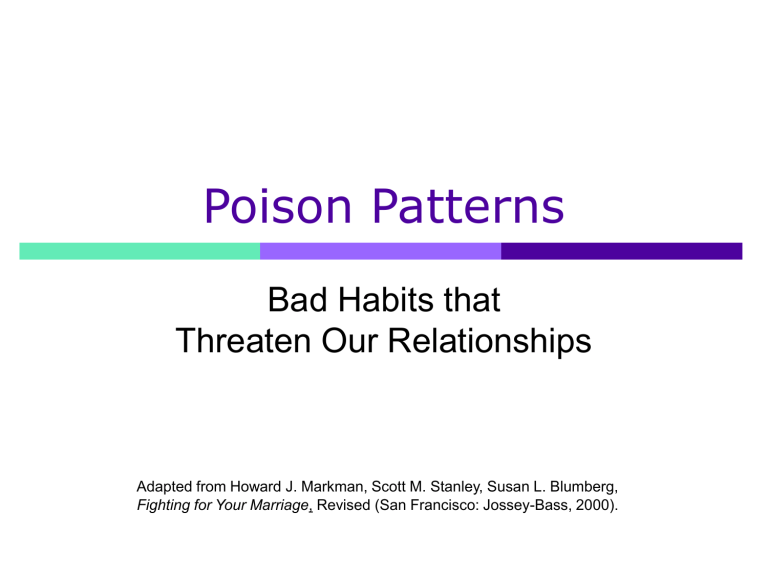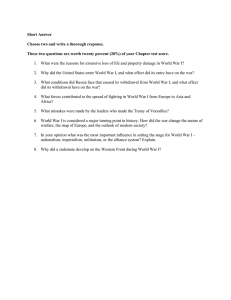
Poison Patterns Bad Habits that Threaten Our Relationships Adapted from Howard J. Markman, Scott M. Stanley, Susan L. Blumberg, Fighting for Your Marriage, Revised (San Francisco: Jossey-Bass, 2000). Each Person Has an Emotional “Bank Account” 1. Affection and care act as deposits Regular deposits keep a relationship strong and resilient Each Person Has an Emotional “Bank Account” 1. Affection and care act as deposits Regular deposits keep a relationship strong and resilient 2. Tensions and hurts act as withdrawals 1 negative interaction makes a withdrawal worth 5-10 deposits All Relationships Have Conflict Key difference is how conflict is managed Among married couples, about 80% of differences cannot be resolved Happy couples don’t let disagreements poison their friendship; distressed couples do 4 Poison Patterns These habits quickly drain warmth and safety 1. Criticism: Painful Putdown 4 Poison Patterns These habits quickly drain warmth and safety 1. Criticism: Painful Putdown 2. Contempt: Character Assassination 4 Poison Patterns These habits quickly drain warmth and safety 1. Criticism: Painful Putdown 2. Contempt: Character Assassination 3. Defensiveness: Victim’s Vengeance 4 Poison Patterns These habits quickly drain warmth and safety 1. Criticism: Painful Putdown 2. Contempt: Character Assassination 3. Defensiveness: Victim’s Vengeance 4. Stonewalling: Hide and Seek Pursuer-Withdrawer Dance 1. Pursuer brings up issues or pushes for a decision 2. Withdrawer pulls away Pursuit Withdrawal Pursuer-Withdrawer Dance 1. Pursuer brings up issues or pushes for a decision 2. Withdrawer pulls away Both reinforce each other 1. The more one pursues, the more the other withdraws 2. Withdrawal provokes more pursuit Pursuit Withdrawal Pursuer-Withdrawer Dance Men Tend to Withdraw Talk to solve problems, not vent feelings Are less able to discuss feelings Are more confused and threatened by conflict “Rules“ for harmony unclear Withdrawal is to reduce distress See female pursuit as being disrespectful, over-sensitive and provoking a fight Women Tend to Pursue More aware of and unsettled by relational problems Prefer to talk to connect Like to discuss the relationship Are less threatened by conflict See male withdrawal as uncaring and cowardly Reducing Withdrawal Recognize it and choose to break the cycle Resist interpreting it negatively Reducing Withdrawal Recognize it and choose to break the cycle Resist interpreting it negatively Pursuers Pursue less and more constructively Use a softer start-up Withdrawers Find a safe way to deal with issues Tool: Stop the Dance I Individually, consider these questions. 1. In what situations am I the Pursuer? Pushing for a decision, discussion or to get something resolved Not easily letting it go Repeatedly bringing it up 2. In what situations am I the Withdrawer? Frequently trying to avoid or escape the discussion or decision Pulling away from the other who is pushing Tool: Stop the Dance II For the Pursuer How can I make it easier for my Withdrawing spouse to be able to have that discussion or otherwise do the thing that I'm pushing for? How can I be more respectful? How can I be more selective and choose my battles? For the Withdrawer How can I volunteer to engage with what my spouse wants, so they don’t have to pursue me? What kind of situation would be most comfortable for me? How can I take responsibility to create that situation? Tool: Time Out Decide on a “Time Out” or “Pause” word or gesture Use before a conflict gets destructive Break for 20 minutes or postpone discussion to a later agreed-upon time Presence of children can be an automatic “Time Out”
